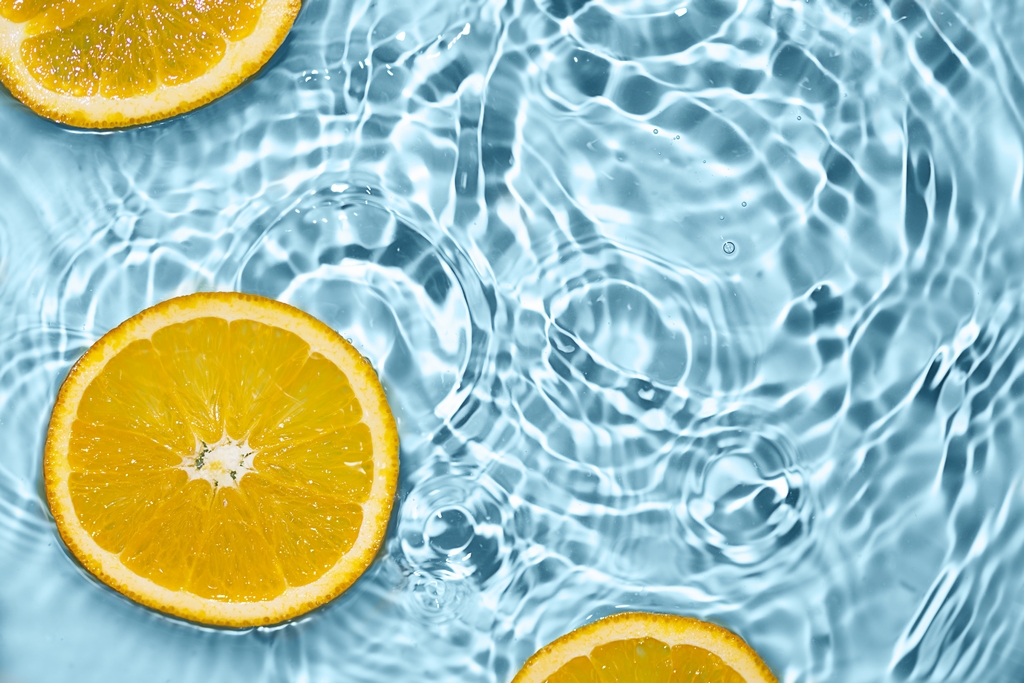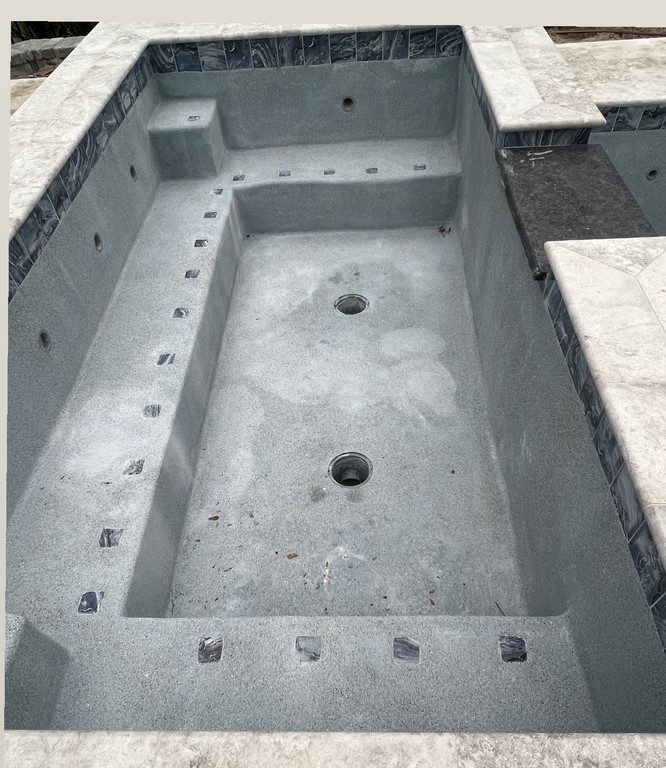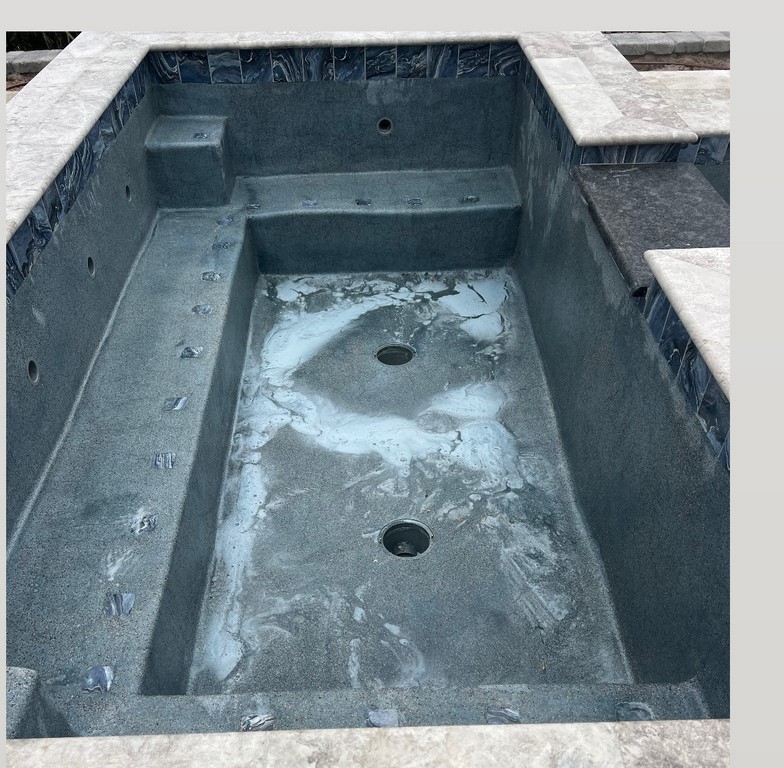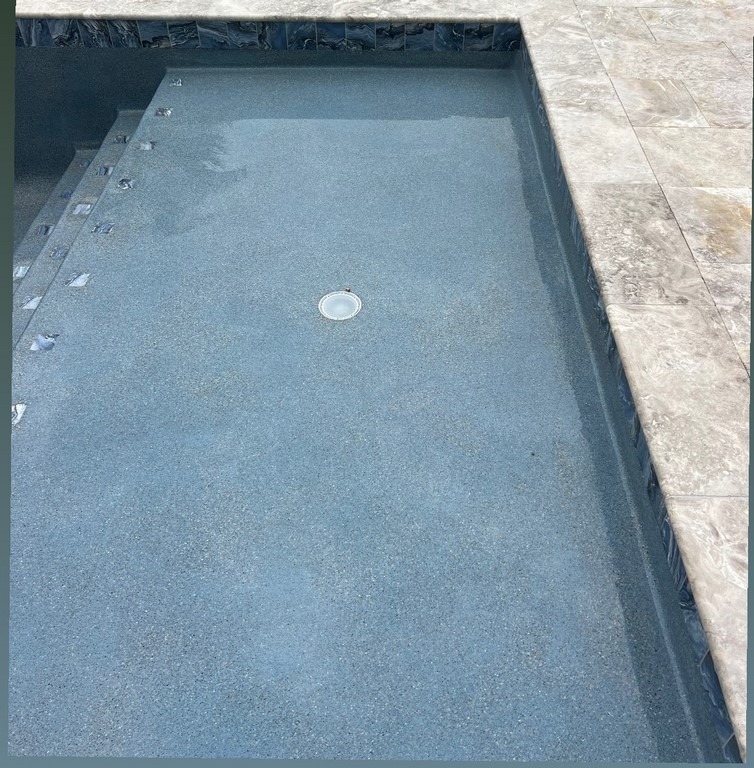Gentle Solutions (Rejecting the Use of Muriatic Acid on Fresh Plaster)


Using acid on newly installed cementitious surfaces is a bad idea, says plaster expert and teacher, Jon Temple. Here he explains his approach to using milder solutions removing mineral residue on exposed aggregate surfaces as a way to avoid common problems and defects.
By Jon Temple
Everything you’re about to read is based on years of careful observation, trial and error, and commonsense. Let’s start with some basics:
When we mix plaster, we’re blending cement aggregates, pigments, and additives together with water to produce pliable material. The mixing process starts the chemical reaction that is going to create the cement we apply to a swimming pool structure.
As a natural part of that process, when you mix something with water, it dries, meaning the water in the mix evaporates. In doing so, the mix water dries to the top where it leaves behind mineral residue in the form of various salts, talc and other stuff that is visible as white-ish residue on the finish surface.
We’ve all seen it, the chalky haze visible on top of a new plaster, and naturally we want get rid of it to make the surface look good. When we acid wash a pool, that’s all we’re doing — removing the material that was left behind during the drying stage.
That may sound simple enough, but it’s where we can, and often do, run into trouble.
HARSH EXPOSURE
The problem is, as an industry, we have made a bad habit of going too far. The application of muriatic acid, which is oftentimes completely undiluted, is overkill. Yet it’s also common practice as I estimate, again based purely on experience, that 95% of people installing exposed aggregate finishes are using undiluted acid to remove the residue from the bleed water.
I was once one of them, but after taking a long and critical look at what we were doing, and the results we were seeing, I have gone in a completely different direction, with far better outcomes. Bottom line, and if you read no further, know with complete certainty that you do not need to use a solution that powerful to remove the mineral residue left behind.
We already know it’s not necessary to expose the pebbles or polished aggregates; that’s done mechanically with a pressure wash wand, or a very mild chemical solution provided or recommended by the surface material manufacturer.
So, the acid wash is only used to remove the residue. It’s important to keep in mind that those salts are not as strong as the cement that’s still there because the cement still has some moisture in it. Those are the weak salts, the weak binders that were in the cement.
By wanting to remove those residual mineral compounds, we are inadvertently damaging the plaster that’s holding the aggregate in place. That’s because when you hit it with the highly acidic solution, it starts to break down the matrix of the cement itself, which also creates plaster dust that has to be cleaned. Just as impactful, the acid affects the porosity of the plaster.
PIGMENTS & CAPILLARIES
The muriatic acid opens up the capillaries that form naturally in cement. When the capillaries become wider and deeper, it allows more plaster dust to form, makes the plaster more susceptible to a range of problems, and it changes color because it affects the pigments.
So, let’s talk about the pigments, specifically organic pigments, which contain iron oxide. Iron is a metal and acid will rust that metal. It will oxidize it and turn it black or gray. Even on a pebble surface, which will hide some plaster discoloration, the damaged pigment will be visible, and very likely result in an unhappy customer.
The big problem is that once you rust those pigments, you have no idea how deep it goes. It’s like when you have a rusted spot on your car. You sanded it and you repainted it, but it’s still going to re-rust. That’s what happens when acid washing a swimming pool. You’ve rusted the metals that are in the pigments through and through, and the blemishes will always return.
The rust penetrates down into and through the pores; and, as you rust those pores deeper, you will get a darker color. That means if you have a blue pool, you’re going to have black spots wherever the acid salt and the rust penetration was deepest.
That is the biggest complaint, along with streaks, footprints and scale—and they all come from this unnecessary acid-washing procedure.
Ultimately, this comes down to the same exact reason that we balance water later on when the pool is full. Acidic water will damage the plaster, making it more porous and susceptible to scale, algae and stains. When we hit new plaster with straight acid, you’re doing the same exact thing, just at a dramatically accelerated rate.
This problem is all in the rearview mirror for our company because, quite simply, we have found a better way — one that is based on a much gentler approach to welcoming a new surface into existence.
ARTISAN TOUCH
Using a food analogy, which does seem to get people’s attention, when you go to the supermarket, you can either buy a frozen dinner, the kind we used to call TV dinners, pop it in the microwave and then feast on food that is inevitably disappointing if not outright terrible. Or, you can buy a filet mignon and a lobster tail, and then take the time to cook it to perfection.
That’s the choice you face in treating new plaster. Hitting it with muriatic acid is harsh and unhealthy; but it’s also fast and cheap, which is why it’s so popular. Or, you can give the plaster the far more gourmet treatment, creating a more durable and beautiful finish.
Here’s my recipe:
New plaster is going through complex and delicate chemical changes, and you need to work with it in a way that complements those natural chemical processes. Even though plaster is a manufactured product, you are still best served by working with nature, not against it.
Specifically, this is why after we expose the aggregate, I let the plaster set for at least 24 hours. The reason for the delay is the surface is exposed to CO2 in the atmosphere, which carbonates the plaster. In the simplest terms, this natural process of carbonization transforms some of the more soluble components in the cement to less soluble compounds.
A note on calcium hydroxide: Many believe that because calcium hydroxide is the most soluble compound in cement, removing it via acid washing is somehow a good thing. Calcium hydroxide is actually an integral part of the cement matrix and contributes to its strength. Gently transforming it using atmospheric CO2 by contrast further strengthens the plaster.
THE WASH
But what about that pesky white mineral residue left behind from the mix water evaporating? At the risk of sounding like I’m contradicting myself, I do use an acidic solution to clean the surface. But it’s extremely mild and does not involve muriatic acid, which I view as a horrible waste product that the industry should have never started using in the first place.
Instead, I use a one-to-five mix of citric acid to water. Citric acid is, by its nature, a far less harsh and corrosive form of acid than muriatic; and, it’s completely non-toxic. When you dilute it, the solution is extremely mild and safe to use, both for applicators and the surface to which it is being applied. But it is acidic enough to remove the mineral residue. You’re just not doing any damage in the process.
It’s my position that citric acid should replace muriatic acid in our industry, at least when it comes to treating cementitious surfaces. It gets the job done, but in a far more controlled manner.
Consider that when you apply straight acid, or a very strong acidic solution, to a newly applied pebble surface, you know it’s opening up pores and going below the surface. But, you have no idea how far down it’s penetrating, which is why pebbles fall off. The concrete holding them in place has been damaged to the point where it no longer do so.
With a mild citric acid solution, you can rest assured that the only thing you’re impacting is the mineral residue. It will not damage the plaster, and as discussed above, it will not harm the pigments.
The reason that citric acid has not been widely adopted is simply because it’s more expensive than muriatic acid. One might suggest, however, this is a classic example of being pennywise and pound foolish. Using muriatic acid is largely a matter of habit in our industry, part of the “the way I’ve always done it” mentality.
GOING NEUTRAL
To further protect and strengthen the plaster, we add one more step – a bicarbonate wash.
Even when you use a mild acid solution, you’re still lowering the pH of the concrete surface. If left uncorrected, that shift in the surface chemistry of the plaster can have a damaging long-term effect. It will slowly corrode the surface.
This is why, using a sump pump for recirculation, we wash the entire surface repeatedly with a solution of sodium bicarbonate and water. This added step gently raises the pH of the cement surface and, because the bicarb has a lightly abrasive quality, it further cleans the surface.
There’s another big upside of the adding this step to the procedure. Bicarb also chemically lowers the temperature of plaster. In doing so it reduces the formation of plaster dust and helps prevent shrink cracking.
Furthermore, the citric acid and bicarb are entirely biodegradable!
I’ve used the simple method on more than 20,000 pools, and not one has resulted in a callback.
This is why I am firmly convinced that we need to rethink our use of acidic solutions on fresh plaster surfaces. The results we’re providing our clients, serving them you might say, will be far more satisfying.
Jon Temple is president and founder of Tempool, a pool-surfacing firm located in Jacksonville, FL. Temple founded the company in 1996, which has plastered more than 30,000 pools. He is a valued Watershape University faculty member.












